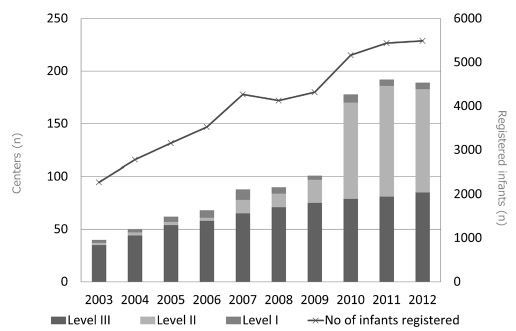Perinatology.
2017 Mar;28(1):1-3. 10.14734/PN.2017.28.1.1.
Our challenges for the Intact Survival of Newborn Babies
- Affiliations
-
- 1Department of Perinatology, Osaka University Hospital Perinatal Center, Osaka, Japan. kwada@ped.med.osaka-u.ac.jp
- KMID: 2376570
- DOI: http://doi.org/10.14734/PN.2017.28.1.1
Abstract
- The neonatal mortality rate has been consistently maintained at 1.1 deaths per 1,000 live births in Japan, which is the lowest level in the world. In addition, long-term survival and prognosis of extremely preterm infants, including neonates born at 22-23 weeks of gestation, has continued to improve. In order to provide high-quality medical care, we had constructed a perinatal transport network, 104 Level 3 perinatal centers, and 292 Level 2 perinatal centers as of 2016. To make additional progress in improving outcomes for high-risk infants, we developed a research database system, "˜Neonatal Research Network Japan (NRNJ)' in 2003. Analysis through this database system enables comparison between various randomized controlled trials, domestically and internationally. To improve quality of care at neonatal intensive care units (NICU), we developed another unique project "INTACT" (Improvement of NICU Practice & Team Approach Cluster-Randomized controlled Trial) in 2011. In this project, we aim to correct the disparity in clinical skills, techniques, and knowledge which exists between facilities, and provide a more equalized, high-quality standard of neonatal care. The neonatal cardiopulmonary resuscitation (NCPR) training program is another strategy which helps maintain our clinical quality. With these challenges, (NRN database, INTACT RC traial, and NCPR program), we will strive towards reaching our goal of "intact survival" of all newborn babies.
MeSH Terms
Figure
Reference
-
1. Health at Glance 2015 OECD Indicators. accessed on 20 January 2017. Available at http://www.oecd.org/health/health-systems/health-at-a-glance-19991312.htm.2. Ishii N, Kono Y, Yonemoto N, Kusuda S, Fujimura M;, Japan . Outcomes of infants born at 22 and 23 weeks’ gestation. Pediatrics. 2013; 132:62–71.
Article3. Neonatal Research Network Database Japan (in English). accessed on 20 January 2017. Available at http://plaza.umin.ac.jp/nrndata/indexe.htm.4. Nakamura T, Yonemoto N, Nakayama M, Hirano S, Aotani H, Kusuda S, et al. Early inhaled steroid use in extremely low birth weight infants: a randomized controlled trial. Arch Dis Child Fetal Neonatal Ed. 2016; F1–FF.5. Shah PS, Lui K, Sjörs G, Mirea L, Reichman B, Adams M, et al. Neonatal Outcomes of Very Low Birth Weight and Very Preterm Neonates: An International Comparison. J Pediatr. 2016; 177:144–152.6. Neonatal Cardio-Pulmonary resuscitation. Japan Society of Perinatal and Neonatal Medicine (in Japanese). accessed on 20 January 2017. Available at http://www.ncpr.jp/.7. Ghavam S, Batra D, Mercer J, Kugelman A, Hosono S, Oh W, et al. Effect of placental transfusion in extremely low birth weight infants: meta-analysis of long-and short-term outcomes. Transfusion. 2014; 54:1192–1192.8. Tsuda K, Mukai T, Iwata S, Shibasaki J, Tokuhisa T, Ioroi T, et al. Therapeutic hypothermia for neonatal encephalaopathy: a report from the first 3 years of the Baby Cooling Registry of Japan. Sci Rep. 2017; 7:39508.
Article
- Full Text Links
- Actions
-
Cited
- CITED
-
- Close
- Share
- Similar articles
-
- Parental Role Stress and Perception of the Newborn in Mothers of Preterm Babies
- Recent Improvements in Medical Expense Support Policies for Newborns in South Korea: Focusing on the Activities of the Korean Society of Neonatology
- A Study on Assessment of Mothers' Perception of a Newborn Baby
- Refractive State of the Newborn
- A Comparative Study of 2, 3-Diphosphoglycerate Levels among Nonpregnant Women, Mothers, and their Newborn Rabies


